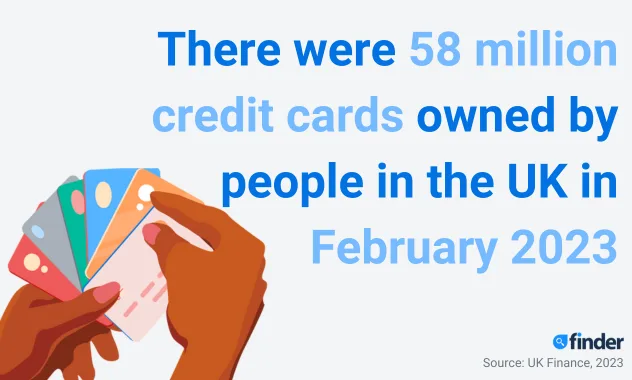Approval for any credit card depends on your status. The representative APRs shown represent the interest rate offered to most successful applicants. Depending on your personal circumstances, the APR you're offered may be higher, or you may not be offered credit at all. Fees and rates are subject to change without notice. It's always wise to check the terms of any deal before you borrow. Most of the data in Finder's comparison tables is provided by Defaqto.
Finder Score for credit cards
To make comparing even easier we came up with the Finder Score. Costs, perks and suitability across 120+ cards are all weighted and scaled to produce a score out of 10. The higher the score the better the card – simple.
Read the full methodologyWhat are 0% purchase credit cards?
0% purchase credit cards allow you to make purchases and pay zero interest on them during the introductory period. When this period ends, the standard purchase rate will be charged on any remaining balance on your card. If you have some big-ticket purchases to make, a 0% purchase credit card can temporarily keep your interest costs low, which could help you pay off the balance faster.
Credit card jargon explained
- APR. The annual percentage rate (APR) is designed to be a benchmark for consumers, providing an annual summary of the cost of your card. As well as the interest, the APR also takes into account any compulsory charges – like an account fee (if there is one). However, crucially, providers only have to give the advertised APR to 51% of those who take out the credit card – the other 49% could be offered a different (higher) rate, at the provider’s discretion. That’s why it’s often referred to as the representative APR.
- 0% purchase period. This is the initial amount of time you’ll have to pay off purchases on your card without incurring any interest charges.
- Variable rate. A variable rate is the opposite of a fixed rate, and can increase or decrease over time at the lender’s discretion. Typically, variations occur as market conditions generally shift – for example an increase or decrease in the Bank of England base rate.
How is a 0% purchase credit card different to a regular credit card?
While a standard credit card typically has an interest rate of between 12% and 25% for purchases, credit cards offering interest-free purchases charge zero interest on all eligible purchases made during the promotional period. If used correctly, a 0% card can save you £100s in interest and be one of the cheapest ways to borrow money.
How to compare 0% purchase credit cards
Each month, our team of experts analyse all the credit cards currently available and rate the most outstanding card for different categories based on a detailed methodology. If you’re looking for the top 0% purchase credit card right now, you can find it in our best credit cards guide. It’s good to keep in mind that if you do apply for a top card, your approval will be dependant on factors like your borrowing history and current income.
You can also find a 0% purchase credit card deal that works for you by comparing the following features:
- Length of the 0% purchase promotion. Different providers offer differing 0% purchase periods, ranging from 3 to 21 months. It’s important that you choose the promotional period which best suits your needs. Consider how much you’re going to spend, divide it by the number of months in the promotional period, and calculate whether you can repay that much each month to clear the balance before the standard interest rate applies. If not, you might want to apply for a card with a longer promotional period or be prepared to incur interest when the offer ends.
- Annual fee. Some 0% purchase credit cards (usually ones that offer extra rewards) charge an annual fee. To determine whether this is worth paying, consider how much you’ll save with the 0% interest offer and any other perks to see whether the benefits outweigh the cost.
- Standard purchase interest rate. If you’re unable to pay your balance in full by the end of the introductory period, your purchases will begin attracting interest at the standard purchase rate. Depending on the card, this will typically be between 12% and 25%, but can be significantly higher. If you don’t think you can repay the entire balance before the promotion ends, look for a card with a lower ongoing purchase rate. Otherwise, you could enjoy another interest-free period by transferring your debt to a card with a 0% balance transfer offer.
- Extra benefits. Does the card come with complimentary travel insurance? Do you want to earn rewards points on your purchases? If you’ll be using the card for more than just the 0% offer, comparing these features can help set the cards apart.
- Your eligibility. Unfortunately, the 0% purchase cards with the longest offer periods and features are often only available to those with an excellent credit history. Thankfully, you can use an eligibility checker to confirm the types of card you’re likely to be approved for before applying.
Credit card purchases of more than £100 and up to £30,000 are covered under Section 75 of the Consumer Credit Act. This means the retailer and your credit card provider are jointly liable if your purchase doesn’t turn up, it arrives damaged or the retailer goes bust.”

Types of 0% purchase credit cards and extra features
While these cards all offer 0% on purchases, there are several types of interest-free purchase credit cards. You can compare the additional benefits and features below to determine which type of 0% purchase credit card is right for you.
| 0% purchase offer type | Benefits |
|---|---|
| Standard 0% purchase offer | Includes the 0% promotional purchase rate for a specified period, which will revert back to the standard purchase rate once the offer has ended. Extra benefits such as interest-free days, travel benefits and complimentary insurances may also be available. |
| 0% purchases with frequent flyer benefits | Earn frequent flyer points for every pound spent on your card for the life of the card and also take advantage of an interest-free purchase promotional period. |
| 0% purchases with balance transfer offers | This type of card allows you to transfer and repay your existing credit card balance interest-free, whilst also making purchases with zero interest. |
| 0% purchases with rewards benefits | Pay no interest on your purchases and earn rewards points for every pound you spend. Unlike a frequent flyer card, these points are connected to your credit card’s rewards programme and can be redeemed for flights, merchandise and cashback. |
Must read: What's the difference between interest-free days and 0% interest credit card offers?
Most credit cards offer a certain number of interest-free days each statement period, for example, up to 55 days. To take advantage of interest-free days, you usually need to pay off your full balance by the due date on each statement. As long as you meet these conditions, you can enjoy interest-free days on your card.
In comparison, credit cards that offer a promotional 0% interest deal on purchases give you a temporary period when you can make purchases without paying any interest. You only have to make minimum payments during the promotional period. But a standard interest rate will apply to any balance remaining at the end of that period.
4 common mistakes to avoid
Want to get the most out of a 0% interest period? Here are 4 things to avoid:
- Ignoring the “revert rate”. At the end of the promotional period, the 0% interest rate will revert to the standard purchase rate (which usually sits between 12% and 25%, but can be higher). Consider the standard interest rate before applying for the card so you understand how your debt will grow if you fail to repay your balance before the promotional period ends.
- Only making the minimum repayment. You’ll be required to make minimum repayments, usually 2% or 3% of the total balance, each statement period. However, if you only match the minimum amount each month, you’ll be unable to repay your entire balance before the 0% offer finishes. If you make more than the minimum repayment, you’ll have a much better chance of repaying your balance before the standard rate applies. If you’re unable to repay your balance before the 0% purchase offer ends, a balance transfer card might be the next step.
- Ineligible transactions. The 0% offer only applies to eligible purchases. If you use your card for balance transfers, cash advances or other cash-equivalent transactions, they’ll usually be charged at the standard rate unless a separate promotional offer applies.
- Not taking advantage of the entire offer period. The 0% offer is available as soon as your card is approved, not from when you make your first purchase. So if your card offers 0% for 6 months but you don’t make a purchase or any repayments for the first month, you’ll only have 5 more months to make repayments without incurring interest. If you have a big purchase in mind, make it as soon as possible and start making repayments immediately to get maximum value out of the offer length.
Bottom line
The introductory 0% interest periods offered by these cards can be a great way to save money on planned purchases and big-ticket items that you need to buy. When you’re comparing these cards, pay attention to how long the promotional period lasts, what interest rate applies at the end of the promotional period, and what other features and fees the card has, so you can find one that best suits your needs.
Ready to compare 0% credit cards?
Frequently asked questions from our users
More guides on Finder
-
Finder Credit Cards Customer Satisfaction Awards 2025
The results of our 2025 Finder Credit Card Customers Satisfaction Awards are in! Find out the winner and most recommended providers.
-
Best credit cards to use abroad in 2025
Pick a card with 0% foreign fees and save big. We’ve rated 20+ cards for spending abroad and listed our top 5.
-
What is the average credit card APR in the UK?
We look at the average APR on credit cards in the UK and how credit card interest rates have changed over time.
-
ASOS credit card (in partnership with Capital One) review
ASOS has launched its own credit card, but how does it weigh up against the market?
-
What’s Monzo Flex and should you get your hands on one?
Find out how to spread your purchases over 3, 6 or 12 months with Monzo Flex.
-
Credit card statistics and trends UK
We look at the latest statistics on credit card ownership and spending in the UK. Here’s what we found.
-
Finder Credit Cards Customer Satisfaction Awards 2020
We reveal the winners and runners-up in our 2020 Customer Satisfaction Awards.
-
Methodology for rating credit cards
Get all the details on how we rate the credit cards we review. We look at costs, fees, features and how well a card performs compared to the rest of the market.
-
Where do Brits go on holiday?: Popular travel destinations
Where do UK residents go on holiday and how many overseas visits do we take? We look at the latest outbound tourism statistics.

